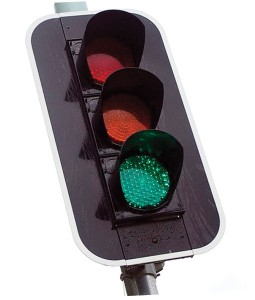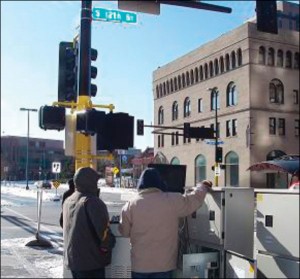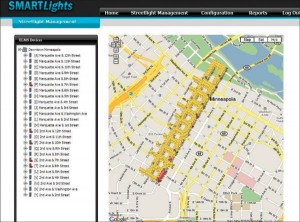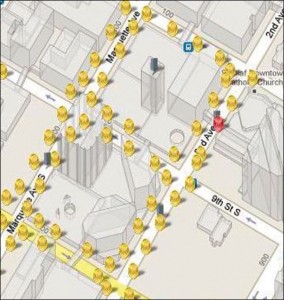What are Intelligent Transportation Systems?
The term intelligent transportation system (ITS) describes the process of adding control, monitoring and communications technology to transportation infrastructure and vehicles to improve safety, reduce energy consumption and to reduce vehicle wear and transportation time.
Development and application of ITS technology is also driven by the need for homeland security. Many of the proposed ITS systems also involve surveillance of the roadways, which is a priority of homeland security. Additionally, through coordination with the US Department of Energy, many ITS applications are also supported, enhanced and on occasion driven by the needs of the Smart Grid electrical distribution technologies
Intent
In 1996, the National Electrical Manufacturers Association (NEMA) teamed with the Institute of Transportation Engineers (ITE) and the American Association of State Highway and Transportation Officials (AASHTO) under a Research Innovative Technology Administration (RITA) Intelligent Transportation System (ITS) Joint Program Office (JPO) contract to obtain more direct user input in the standards development process. The NTCIP Steering Group has been reorganized as the Joint Committee on the NTCIP, an official Steering Committee of the FHWA-funded project.
The Purpose of NTCIP Standards

With proprietary protocols there is virtually no opportunity for realistic competitive bidding as the system expands, due to the lack of interchangeability. Nor, is there any opportunity for realistic competitive bidding to add additional types of field devices to the system, due to the lack of interoperation — or more typically termed interoperability.
NTCIP is a collection of open standards, defining common communications protocols and data definitions. The proper use of NTCIP open standards in an ITS deployment allows future systems expansions to benefit from true competitive bidding; in addition, it allows other types of field devices to be added. NTCIP is an entire family of standards designed to meet the communications needs of various fixed-asset roadside devices and traffic management centers.
Interoperability and interchangeability reduce the total life system costs (procurement, operations and maintenance). Interoperability and interchangeability are two key goals of the NTCIP open standards effort. The terms interoperability and interchangeability generally reflect the ability to use multiple brands of a device on the same communications channel, along with the ability to swap them out. For example, the ability to put any brand of NTCIP-conformant street light controller in the same system at the same time reflects interchangeability for that device type. It is for this reason that the NTCIP family of protocols is being widely embraced and specified in many new system deployments.
The NTCIP is a family of standards that provides both the rules for communicating (called protocols) and the vocabulary (called objects) necessary to allow electronic traffic control equipment from different manufacturers to operate with each other as a system. The NTCIP is the first set of standards for the transportation industry that allows traffic control systems to be built using a “mix and match” approach with equipment from different manufacturers. Therefore, NTCIP standards reduce the need for reliance on specific equipment vendors and customized one-of-a-kind software. To assure both manufacturer and user community support, NTCIP is a joint product of the National Electronics Manufacturers Association (NEMA), the American Association of State Highway and Transportation Officials (AASHTO), and the Institute of Transportation Engineers (ITE). The NTCIP originated as the National Transportation Communications for Intelligent Transportation System (ITS) Protocol (NTCIP)(1)
Benefits of NTCIP
Avoid Early Obsolescence: While retrofitting legacy equipment and systems with NTCIP support is not practical in most situations, most manufacturers offer NTCIP support in their current and future products. It is possible to migrate a system gradually, since it is possible to operate a mixture of NTCIP and non-NTCIP devices in the same system, though not on the same communications line.
Providing “Plug and Play” Vendor Choice: Since a computer system that supports NTCIP can communicate with any product from other manufacturers that are NTCIP-conformant, the number of manufacturers and systems, field devices, or software that can be considered for purchase increases tremendously. NTCIP does make it easier for an agency to gradually change its software, controllers and other field devices from one manufacturer to supporting multiple manufacturers for the entire system.
Enable Interagency Coordination: NTCIP allows agencies to exchange information and (with authorization) basic commands that enable any agency to monitor conditions in other agencies’ systems, and to implement coordinated responses to incidents and other changes in field conditions when needed. Such data exchange and coordinated response can be implemented either manually or automatically. One agency can monitor and issue basic commands, if authorized, to field devices operated by another agency, even though those devices may be from a different manufacturer than those used by the monitoring agency.
Use One Communications Network for All Purposes: NTCIP allows a management system to communicate with a mixture of device types on the same communications channel. For example, with the addition of appropriate application software in the system computer, a dynamic message sign could be installed near a signalized intersection, and the computer could communicate with the sign controller using the communications line or channel already in place for the traffic signal controller.
Acronyms
AASHTOAmerican Association of State Highway and Transportation Officials
ARRAAmerican Recovery and Reinvestment Act
DOEDepartment of Energy
EISAEnergy Independence and Security Act
ELMSElectrical and Lighting Management Systems
FHWAFederal Highway Administration
ITEInstitute of Transportation Engineers
ITSIntelligent Transportation System
NEMANational Electrical Manufacturers Association
NISTNational Institute of Standards and Technology
NTCIPNational Transportation Communications for Intelligent Transportation System Protocol
RITA ITS JPOResearch Innovative Technology Administration; Intelligent Transportation
System; Joint Program Office
SAFETEA-LUSafe Accountable, Flexible, Efficient Transportation Equity Act: A Legacy for Users
TMCTraffic Management Center
LED Adaptive Lighting, Intelligent Transportation Systems and the Smart Grid
Transportation Systems and the Smart Grid
Smart Grid Interoperability Standards Project
As specified in the American Recovery and Reinvestment Act (ARRA), NIST received $10 million through the Department of Energy (DOE). This resource commitment has created a substantial effort to develop a comprehensive interoperability framework for a nationwide Smart Grid for the U. S. electric power system.

The Smart Grid is a critical key to national efforts to further energy independence and curb greenhouse gas emissions. With industry, government, and consumer stakeholders, NIST is expediting identification and development of standards critical to achieving a reliable and robust Smart Grid.
Interoperability—the ability of diverse systems and their components to work together—is vitally important to the performance of the Smart Grid at every level. It enables integration, effective cooperation, and two-way communication among the many interconnected elements of the electric power grid.
Effective interoperability is built on a unifying framework of interfaces, protocols, and the other consensus standards. These standards facilitate useful interactions so that, for example, “smart” appliances and meters will tell consumers how much power they are using and at what cost, providing them with more control over their power consumption and energy bills. Widely adopted standards also will help utilities to mix and manage varying supplies of solar, wind, and other renewable energy sources and better respond to changing demand. Support of the ITS NTCIP 1213 standard allows inclusion of ITS projects into the Smart Grid domain.

Figure 1. Downtown Minneapolis’ ITS ELMS Smart Grid covers 26 city blocks.
The task for this US DOE / NIST Smart Grid effort is very similar to the process that the US Department of Transportation implemented for developing standards for the Intelligent Transportation domain. Like standards in the ITS world, Smart Grid interoperability and cyber security standards reflect industry consensus, with active participation, and where required, leadership and coordination by government.
Expediting the Process
Accelerating development of the Smart Grid ranks among the Obama Administration’s top priorities. Funding through the American Recovery and Reinvestment Act provides a tremendous opportunity to “jump start” implementation of the Smart Grid.
On February 3, 2010, NIST issued a “roadmap” for Smart Grid interoperability standards. This document resulted from the compilation and distillation of hundreds of stakeholder comments. This roadmap, available online at www.nist.gov/smartgrid references ITS NTCIP 1213 “ELMS” as a supported application standard, making ELMS projects eligible for Federal Smart Grid funding. In addition, to the currently developed standard, an evolution of the NTCIP 1213 standard is underway to include support for electric vehicle charging stations, and for support of wind and photovoltaic power generators.

A Look at an Integrated ELMS Smart Grid in Minneapolis
Since these assets are exposed to the environmental extremes of Minnesota, traffic accidents and occasional vandalism, they need to be strong and robust. Additionally, ongoing deterioration of this field-mounted equipment leads to increased maintenance costs, energy usage and system failures that can cause accidents or even deaths.
Traditionally, repairing inoperable roadway lighting components required visual confirmation of the problem. A passing motorist may report that a light or series of lights are out. Pedestrians typically reported electrical leakages.
When a report of an issue occurs, a maintenance crew from the organization is normally dispatched for an inspection, which in turn, accumulates overhead, personnel, and vehicle maintenance costs. Sometimes, a second or third trip to the site may be necessary to complete repairs, incurring even more expenses.
Obvious costs related to these issues are oil changes, tire replacement, and the increasing cost of fuel. Less obvious, but equally notable are the environmental impacts of greenhouse gas emissions from the trucks, and the costs and environmental impacts associated with the disposal of waste oil, tires, and the service vehicle itself. Minneapolis faced many of these issues with their existing infrastructure.
In light of these issues, the city of Minneapolis subsequently chose to take a proactive step forward, accomplished through the installation of an ITS ELMS Smart Grid covering twenty-six city blocks in the downtown business and entertainment districts.
Among its many features, this Smart Grid system includes individual streetlight control and monitoring including scheduling of each light. Revenue grade metering at each roadside electrical service cabinet is offered along with circuit-based ground fault detection. Reporting functions automatically alert the appropriate personnel of system anomalies, including pole knockdowns, light outages and dangerous electrical leakage conditions.
The infrastructure data is conveyed to and from data logger computers, which reside in each service cabinet. Each data logger communicates back to the Public Works central office over a robust fiber ITS compliant backbone, At the Public Works Traffic Management Center (TMC), Strategic Telemetry’s SmartLights™ software interprets and displays the information collected by data loggers, Additionally SmartLights™ sets the field operational parameters, including lighting dim levels, lighting schedules and alarm levels for the ground-fault detectors.
The result is that hundreds of streetlights and dozens of roadside electrical service cabinets can be remotely controlled and monitored — saving energy, conserving the city’s maintenance assets, and increasing safety to the vehicle operator and pedestrian alike. A significant added benefit is that payback of systems such as these can be in as little as five years.
Funding
ELMS and ITS have been funded through the national surface-transportation legislation known as Safe Accountable, Flexible, Efficient Transportation Equity Act: A Legacy for Users (SAFETEA-LU). The reauthorizing bill drafted by Congressman James Oberstar (D-Minn.) includes significant support for ITS applications generally, and more specifically for NTCIP 1213 compliant energy and safety applications.
More recently, funding was also available through the American Reconstruction and Reinvestment Act of 2009 (ARRA), the Department of Transportation’s Federal Transit Administration, and the Department of Energy’s Smart Grid programs, as referenced in the NIST Framework and Roadmap for Smart Grid Interoperability. Other programs that offer federal matching funds for ELMS projects include the Smart Communities Innovation Initiative.
Summing Up
The standards and technologies of the Intelligent Transportation Systems effort and those of the Smart Grid are converging.
Leveraging the complementing benefits and strengths of each can lead to a range of broad variety of infrastructure enhancements that save time, resources and lives.
These systems are very cost effective — often yielding a payback in the range of five years.
References:
[1]www.nist.gov/smartgrid. “NIST Framework and Roadmap for Smart Grid InteroperabilityV1.0 .”
[2]Frazer, Jim. “Saving Time, Energy & Lives Using ELMS.” IMSA Journal, (July/August 2008).
[3]Burkett, Karl. “Is ELMS The Answer?” www.karlburkett.com (December 2004).
[4]Frazer, Jim. “Maintaining Roadway Lighting and the Environment.” IMSA Journal, (September /October 2008).
[5]ITS NTCIP 1213: Electrical Lighting and Management Systems. Published by The Joint AASHTO / ITE /NEMA Committee on the NTCIP














Find Us on Socials